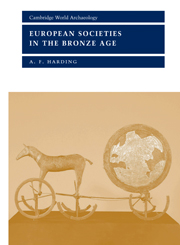Book contents
- Frontmatter
- Contents
- List of figures
- List of tables
- Preface
- 1 Introduction
- 2 The Bronze Age house and village
- 3 Burial
- 4 The domestic economy
- 5 Transport and contact
- 6 Metals
- 7 Other crafts
- 8 Warfare
- 9 Religion and ritual
- 10 Hoards and hoarding
- 11 People
- 12 Social organisation
- 13 The Bronze Age world: questions of scale and interaction
- 14 Epilogue
- References
- Index
13 - The Bronze Age world: questions of scale and interaction
Published online by Cambridge University Press: 25 January 2010
- Frontmatter
- Contents
- List of figures
- List of tables
- Preface
- 1 Introduction
- 2 The Bronze Age house and village
- 3 Burial
- 4 The domestic economy
- 5 Transport and contact
- 6 Metals
- 7 Other crafts
- 8 Warfare
- 9 Religion and ritual
- 10 Hoards and hoarding
- 11 People
- 12 Social organisation
- 13 The Bronze Age world: questions of scale and interaction
- 14 Epilogue
- References
- Index
Summary
The attempt in the previous chapter to reconstruct aspects of social organisation was restricted to the individual, the group or the tribe, implying a geographically restricted area. Each tribal territory was, however, part of a wider continent. Though ‘Europe’ as a concept did not exist, the continent did: where no geographical barriers existed the inhabitants of one area had no reason not to be aware of their neighbours and of those neighbours' neighbours. Every person had a ‘world’ and a ‘world view’, but identifying the components of that view is not an easy matter. In particular, the identification of an overarching world that encompassed large parts of present-day Europe is something that has engendered intense debate.
Attempts at reconstructing a ‘Bronze Age world view’ can only ever be speculative in a Europe where the absence of literacy prevents mind-to-mind contact across the ages. Understanding is necessarily determined by familiarity with a variety of models relating to both past and present societies, derived from history and ethnography. Such models can provide several alternative views of the same society, though there may be others which are more appropriate though less well known (fig. 13.1).
Diffusion or local evolution?
Traditionally the European Bronze Age has been seen as some kind of appendage to the rich civilisations of the East Mediterranean. Most of the inventions which characterised the period were of Near Eastern origin, including metallurgy, wheeled transport, swords and body armour, and were thought of as spreading across Europe from the south-east, in classic diffusionist fashion.
- Type
- Chapter
- Information
- European Societies in the Bronze Age , pp. 414 - 430Publisher: Cambridge University PressPrint publication year: 2000

